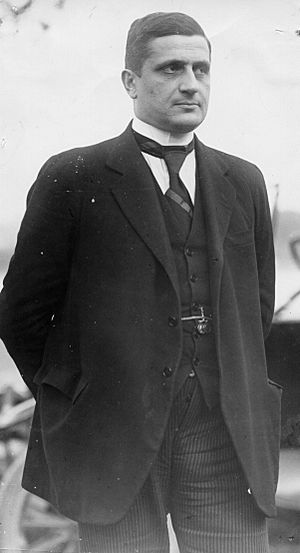Giovanni Amendola facts for kids
Quick facts for kids
Giovanni Amendola
|
|
|---|---|

Amendola in 1923.
|
|
| Minister of the Colonies | |
| In office 26 February 1922 – 30 October 1922 |
|
| Prime Minister | Luigi Facta |
| Preceded by | Giuseppe Girardini |
| Succeeded by | Luigi Federzoni |
| Member of the Italian Chamber | |
| In office 1 December 1919 – 7 April 1926 |
|
| Constituency | Salerno |
| Personal details | |
| Born | 15 April 1882 Naples, Italy |
| Died | 7 April 1926 (aged 43) Cannes, France |
| Political party | Italian Socialist Party (1897–1899) Italian Radical Party (1900–1919) Democratic Liberal Party (1919–1926) |
| Spouses |
Eva Kuhn
(m. 1906–1926) |
| Children | Giorgio (1907–1980) Adelaide (1910–1980) Antonio (1916–1953) Pietro (1918–2007) |
| Alma mater | University of Florence |
| Profession | Journalist, philosopher |
Giovanni Amendola (born 15 April 1882 – died 7 April 1926) was an important Italian journalist, professor, and politician. He is best known for being a strong opponent of Italian fascism, a political movement led by Benito Mussolini.
Contents
Biography
Early life and education
Giovanni Amendola was born in Naples, Italy, on 15 April 1882. When he was young, he moved to Rome. There, he finished middle school. At just fifteen years old, he joined a socialist youth group. The next year, he started working as an apprentice at "La Capitale," a newspaper of the Italian Radical Party.
Amendola later earned a degree in philosophy. He wrote for well-known magazines like Leonardo and La Voce. After his studies, he became a professor of philosophy at the University of Pisa. Between 1912 and 1914, Amendola was the editor of a daily newspaper called Il Resto del Carlino. He also worked for Corriere della Sera from 1914 to 1920.
Political career and opposition to fascism
Giovanni Amendola became very interested in politics. He was elected three times to the Italian Chamber of Deputies (like a parliament) for the city of Salerno. In the 1910s, Amendola supported the liberal movement in Italy. However, he strongly disagreed with the ideas of another politician, Giovanni Giolitti.
During World War I, Amendola believed in a democratic approach to uniting Italian lands. After the war, he was chosen to be a minister by Prime Minister Francesco Saverio Nitti.
Amendola was very critical of extreme right-wing groups, especially the Fascists. Because of his strong views, he was attacked several times by Fascist supporters. In 1924, Amendola refused to join the "Listone Mussolini," which was a list of candidates supported by Benito Mussolini. Instead, Amendola tried to become Prime Minister himself, leading a group of liberal politicians in the elections. He did not win, but he continued to fight for democracy. He did this by writing articles for Il Mondo, a new newspaper he started in 1922 with other thinkers.
During a major political crisis in 1924, Amendola published an important document called the "Rossi Testimony." This document, released on 27 December 1924, suggested that Prime Minister Mussolini was involved in the events surrounding the death of Giacomo Matteotti. Matteotti was the leader of the Socialist PSU party, who died on 10 June 1924. In the same document, Amendola also claimed that Mussolini was behind a period of fear and violence leading up to the general elections on 6 April 1924.
Mussolini disliked Amendola because of his strong activism. Giovanni Amendola became one of the first victims of the Fascist government's violence. In July 1925, he was badly beaten by a group of Fascist supporters. Other early victims included Giacomo Matteotti and the priest Don Giovanni Minzoni.
In 1923, Amendola was one of the first to describe Italian Fascism as a new kind of political system called totalitarianism. He explained it as a system where the state has complete political power. He saw it as very different from traditional dictatorships. Later, Giovanni Gentile, a famous Italian philosopher and supporter of fascism, used the term totalitario in a positive way. He used it to describe a new state that would fully represent the nation and guide its goals.
Death
Giovanni Amendola died on 7 April 1926 in Cannes, France. His death was a result of the severe injuries he received when he was beaten by Fascist supporters in July 1925.
Personal life
Giovanni Amendola married Eva Kuhn in 1906. They were married until Amendola's death in 1926. They had four children together:
- Giorgio Amendola (1907-1980), who grew up to be an important communist writer and politician.
- Adelaide (1910-1980).
- Antonio (1916-1953).
- Pietro (1918-2007), who also became a journalist and politician.
See also
 In Spanish: Giovanni Amendola para niños
In Spanish: Giovanni Amendola para niños

